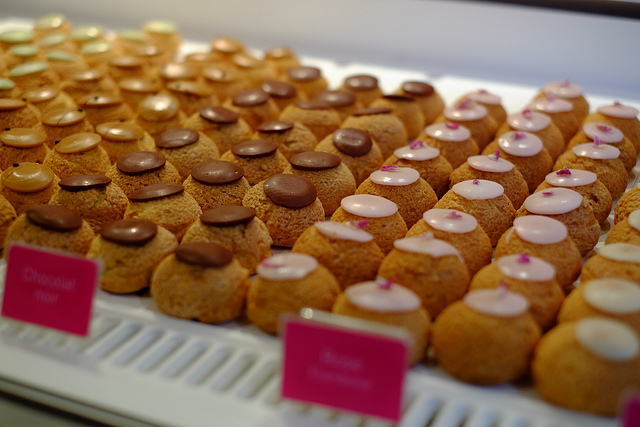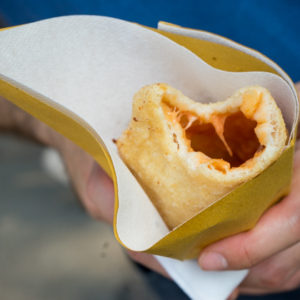Summer is ending. A sense of melancholy lingers in the air at the thought of putting away the sandals, sundresses and swimsuits. No more sunny days outdoors on picnics, swimming or walks. Strawberries are starting to turn sour, peaches are sold a bit more firm, their luscious perfume lost. But summer turns to autumn, a season of leaf peeping, hazelnuts, roasted chestnuts, truffles and slightly richer, earthier foods.
To every ending is a new beginning. So as I put away my swimsuit for the season and school begins, freeing me up a bit, I can make bongo (also known as profiteroles or cream puffs) to reassure everyone that all is not lost.

Popelini by Norio Nakayama

Cream puffs at Popelini by Edward Kimber
Cream puffs or choux in French have become all the rage, replacing the rainbow-coloured macaroons in places from Paris (try Popelini in the Marais) to Hong Kong (try 126 grammes). These very fashionable pastries are puff pastry filled with a variety of creative creams from mango, yuzu and green tea in Asia to salted caramel, Earl Grey tea and vanilla and rose in Europe. In Firenze (Florence) they are called bongo and are traditionally filled with whipped cream and coated in chocolate glaze.
While profiteroles and choux pastry are generally considered to be of French origin (think eclairs), they were invented by one of Catherine de’ Medici’s chefs, Popelini (presumably this is where the pastry shop in Paris derives its name) and in French are even sometimes called popelin or poupelin. (Catherine de’ Medici was a 16th century Tuscan noblewoman who married King Henry II of France.) My favourite version of profiteroles is filled with and coated with chocolate mousse and the added benefit is our gluten-free friends are not left out as they can still enjoy the chocolate mousse on its own. Here is my recipe for creamy, decadent cream puffs to celebrate the beginning of autumn:
Recipe:
Bongo / Profiterole (Cream puffs)

Filling the choux pastry with chocolate mousse
For illustrated step-by-step instructions, click here.
Chocolate mousse (mousse al cioccolato):
220 grams dark chocolate
450 grams whipping cream (36% fat)
3 grams gold gelatin leaf
190 grams sugar
75 grams water
130 grams yolks
Choux pastry (Pasta beignet):
400 grams butter, cut into flakes
250 grams water
250 grams milk
400 grams 00 flour for frolla, sifted
875 grams (15-20 extra-large eggs) fresh eggs (fresh egg whites will help the dough rise more)
Instructions:
Chocolate mousse (mousse al cioccolato):
For illustrated step-by-step instructions, please click here.
To make the chocolate mousse, soak the gelatin leaf in cold water to soak.
Whip the cream until still slightly soft or else it won’t fill the mould well.
Add water to a saucepan and then add the sugar. Heat the mixture to 120°C and remove from the heat. Squeeze out the gelatin and dissolve into the sugar water. Place the yolks in the standing mixer with the whisk attachment. Turn the machine on medium and add the sugar water bit by bit. The yolk mixture needs to be heated to 85°C to make the eggs safe to eat. In a saucepan heat the chocolate to 80°C. Remove 20% of the whipping cream and fold the chocolate in until well combined. Fold in the egg mixture and combine well. When well mixed, add half of the cream and fold to combine. Fold in the remaining whipping cream until well combined.
Choux pastry (pasta beignet):
For illustrated step-by-step instructions, click here.
Heat the oven to 180°C without any fan assistance. The beignets can be baked from 180°C to 210°C. At higher temperatures the dough rises more but they are more irregular. We use 180°C here for the sake of consistency. If you don’t have the option to turn off the fan, then heat the oven to 250C, turn off the oven and add the choux pastry for 15 minutes. Then turn the oven back on to 180C for 10 minutes until golden brown.
Heat the butter, water, and milk together. Remove the pot from the heat and add the flour to the mixture all at once and stir with a wooden spoon until thick (about 5 minutes). The dough should not be sticky. Place the mixture into a standing mixer and mix on medium low using the paddle attachment until it has cooled to a barely warm temperature. Add the eggs one at a time, making sure that the egg is completely incorporated (1-2 minutes) before adding the next one otherwise the dough will break. The key here is to make sure that each egg is evenly incorporated before adding the next one while trying to add them as quickly as possible. When half the eggs have been added there is less risk of the dough breaking so being patient in the beginning pays off later. Before adding the last ¼ of the eggs, stop the machine and scrape down the sides. Since the precise number of eggs to be added varies with the humidity and how dry the dough was when it was removed from the pot, the dough needs to be tested to ascertain it is the correct consistency. Put in a rubber spatula and lift it out with the rubber tip angled down. It should form a triangle slowly running off the spatula. The dough should be smooth, supple and homogenous. If it is too liquid the pastry will be flat and if it doesn’t move at all it will be too dense. If it is too thick then add another egg and do the test again until the dough is the desired consistency.
Grease a sheet pan but do not use any parchment paper. Place the dough into a pastry bag fitted with a round tipped nozzle about 7-8mm wide. Roll the end closed and, if you are right-handed, hold the end with your left hand and grip the bag about 6 cms above the top of the pastry tip with your right, using this hand to squeeze the bag in order to pipe out the dough. The side of the pastry tip should be touching the sheet pan forming a 45° angle to the pan and squeeze the bag with the right hand to form a 4 cm diameter mound, curling the dough on top of the first layer to form two layers. Leave 3 cm between mounds and start the next line to offset the previous line. Cover with cling film ensuring the plastic does not touch the pastry until ready to use.
When ready, remove the cling film and bake in the oven for 20-25 minutes until risen, dark golden, and firm. Do not open the oven during the first 15 minutes. When ready, remove from the oven and place on a rack to cool. They will come out hard and soften over time.
To make the profiteroles:
When the pastry is cool, add 1/3 of the mousse to a pastry bag with a 1 cm nozzle on the end. Place in a cup and refrigerate for 1 hour. Place the tip of the pastry nozzle into the bottom of the choux pastry and squeeze in the mousse to fill it. When they are all filled, pour the remaining chocolate mousse over the top , ensuring they are entirely coated. Refrigerate until ready to eat. The pastry will soften when in contact with the mousse. The pastry should be soft but not soggy.
Enjoy! If you know anyone who is miserable about the change of seasons, please share this with them to cheer them up!
Next week I promise to continue blabbering on about how much I loved Le Marche.






Leave a Reply